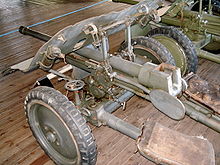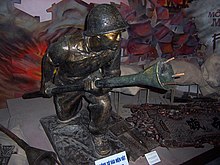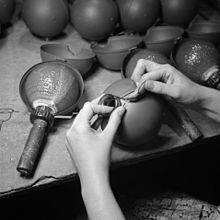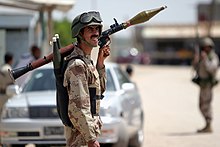User:Koakhtzvigad/Anti-tank warfare
Anti-tank warfare was created by seeking technology and
With the
Although it was a the
The tank threat
Anti-tank warfare evolved as a countermeasure to the threat of the tank's appearance on the battlefields of the Western Front of the First World War. The tank had been developed to negate the German system of trenches, and allow a return to manoeuver against enemy's flanks and to attack the rear with cavalry.[citation needed]
The use of the tank was primarily based on the assumption that once they were able to eliminate the German trench lines with their machine gun and Infantry support gun positions, the Allied infantry would follow and secure the breach, and the cavalry would exploit the breach in the trench lines by attacking into the depth of German-held territory, eventually capturing the field artillery positions and interdicting logistics and reserves being brought up from the rear areas.[citation needed] Naval crews[citation needed] initially used to operate the installed naval guns and machine guns were replaced with Army personnel who were more aware of the infantry tactics with which the tanks were intended to cooperate. However, there was no way to communicate between the tank's crew and the accompanying infantry, or between the tanks participating in combat. Radios were not yet made portable or robust enough to be mounted in a tank, although Morse Code transmitters were installed in some Mark IVs at Cambrai as messaging vehicles,.[1] Attaching a field telephone to the rear would became a practice only during the next war. With greater use of tanks by both sides it was realised that the accompanying infantry could be forced to ground by ambush fire, thus separating them from the tanks, which would continue to advance, eventually finding themselves exposed to close-assaults by German infantry and sappers.
The early tanks were mechanically rudimentary. The 0.23-to-0.47-inch (5.8 to 11.9 mm) armour generally prevented penetration by
First World War
The tank, when it appeared on the Western Front in 1917, was a total surprise to the German troops, though not to the
Anti-tank weapons
Because the German Army was the only force in need of anti-tank weapons, it was they that had to develop a viable technology to combat the tank. These technologies took three
Anti-tank tactics
With the appearance of Allied tanks the German Army were quick to introduce new anti-tank defense detachments[citation needed] within the pioneer battalions of the infantry divisions. These were initially issued 1.3 cm calibre long barrel rifles firing solid shot. However these suffered from fouling after 2-3 rounds and had a recoil that was unsustainable by the mechanism or the rifleman.[citation needed] Stick grenades were used to destroy the tracks by individual pioneers, however this required for accompanying machine-gunners to first separate the supporting Allied infantry line from the tanks, which proved difficult.[citation needed] Another tactic was to lure the tank beyond the German trench-line, re-establishing it just as the Allied infantry approached.[citation needed] The tank would then be engaged by the divisional 7,7 cm guns brought forward, that would try to disable the tracks with ordinary HE shells (and later AP ammunition). If the crews of the disabled tanks refused to surrender, they were engaged with flamethrowers, or a mortar would be fired on the stricken vehicle until a direct hit was achieved on the top surface, usually resulting in an internal fire.[citation needed] Finally, anti-tank obstacles were prepared on the likely approaches by deepening and widening existing ground cratering, the precursors of the anti-tank trench.[citation needed] In early 1917 the 3.7cm TaK from Rheinmetall was rushed to the frontline, and proved effective in destroying the tanks despite limited elevation and traverse.
Development between the World wars
Lack of consensus on the design and use of the tank after the First World War also influenced A LACK OF anti-tank countermeasures development.[citation needed] However, because Germany was restricted in its military capability, and there were no other challenges to France and Britain, very little development took place in anti-tank warfare until the 1930s.
The
Improved artillery was seen as the quickest solution to anti-tank defense[
At this time the predominant ammunition used against tanks was the
The only significant attempt to experiment in the use of tanks in the late 1920s was that of the British Army's
In Spain the anti-tank defense of the Nationalists was organised by the
The only change[citation needed] to the German anti-tank tactics of the First World War was that now an effective anti-tank weapon was available to support the defending infantry. However, the Soviet tanks armed with 45 mm guns easily destroyed the German light tanks.[citation needed]
Ironically, in the early 1930s until the Spanish War, German officers were conducting secret testing of a new way of employing tanks, infantry and artillery
The new doctrines of using the tank, were divided into infantry and cavalry schools of thought.[citation needed] The former regarded the tank as a mobile artillery system to be used for infantry support. This suggested that the infantry needed to be armed with integral anti-tank weapons. The later advocated use of tanks in the traditional cavalry way of high tempo attacks intended to outflank the enemy infantry and sever its communication lines. This approach suggested that the tank would be the best anti-tank system, and only limited anti-tank troops were required to accompany them. For this reason the late 30s tank configurations came in a great diversity, ranging from light tankettes and 'cavalry tanks' to multi-turreted heavy tanks resembling bunkers, all of which had to be considered in training by the anti-tank artillery troops.[citation needed] The development of these doctrines was the most significant influence on the rapid development in anti-tank technology and tactics in the Second World War.[citation needed]
Second World War
replace with a proper military field engineering article
Two aspects of how the Second World War commenced helped to delay development of anti-tank warfare: resignation and surprise.[
Anti-tank air tactics
As tanks were rarely used in conflicts between the two World Wars, no specific aircraft or tactics were developed to combat them from the air. One solution adopted by almost all European air forces was to use bomb loads for conventional bombers that were composed from small bombs allowing a higher density during bombing.[
Field artillery against tanks
Field artillery were often the first ground combat arm to engage detected concentration of troops that included tanks through airborne artillery observers, either in assembly areas (for refueling and rearming), during approach marches to the combat zone, or as the tank unit was forming up for the attack. Conventional artillery shells were very effective against the tank's thinner top AND SIDE armour if fired in appropriate density while the tanks were concentrated, enabling direct hits by a sufficiently powerful shell.[
Anti-tank guns

Anti-tank guns are guns designed to destroy tanks and other armored vehicles from
Prior to
At the start of
Germany quickly introduced more powerful anti-tank guns, some which had been in the early stages of development prior to the war.[

- Mobile anti-tank guns
Lighter anti-tank guns retained
Some German-designed tank destroyers employed light French or Czech design tank chassis by installing an AT gun on a turret-less superstructure to reduce weight, increasing mobility. Most German and Soviet designs used a reduced silhouette of a tank hull to enable firing from
By the end of the war the concept of the dedicated, conventional anti-tank gun was declining,[citation needed] ref to production stats as the German tank fleet was reduced through attrition. Late in the war recoilless 'rifle' weapons were being developed as anti-tank gun replacements.[citation needed] in which countries?
Anti-tank rifles
Anti-tank rifles were introduced in some armies before the Second World War to provide infantry with a stand-off weapon when confronted with a tank assault. The intention behind the capability was to preserve good morale of the infantry by being able to trust in a weapon that could defeat the tank which acquire such a fearsome reputation during the First World War and the inter-wars period. Notable examples include the
Tactical employment of the anti-tank rifle was different in the Red Army to other armies. Although by 1943 in other armies the anti-tank rifle was judged to lack combat effectiveness due to their diminished ability to penetrate the thicker armour of new tanks, the anti-tank rifle remained in Soviet use during the conflict for its place in the system of anti-tank defensive tactics.
Infantry anti-tank weapons

The development of light, man-portable, anti-tank weapons increased during the Second World War. Most were based on the
After the war, research on infantry anti-tank weapons continued, with most designers focused on two primary goals; first, an anti-tank weapon that could defeat more heavily-armored postwar tanks and fighting vehicles, and second, a weapon lightweight and portable enough for infantry use.
Mines and other explosives

- Hawkins mine
- The Wehrmacht employed the Goliath tracked mine, an unmanned demolition vehicle
- The Soviet Union employed anti-tank dogs during World War II, with very limited success; as a counterpart to the German Goliath the Teletank was used as a remote-controlled unmanned tank
- The Japanese forces employed suicide attacks with pole-mounted anti-tank mines dubbed Lunge Mines during late World War II[4]
Grenades

There were many types and kinds of anti-tank grenades. These ranged from
There was also a special type of grenade called the Nebelhandgranaten or Blendkörper ("smoke hand grenades"), which was supposed to be smashed over an air vent and fill the tank with smoke, widely used by both sides in
Second World War anti-tank tactics
This article needs additional citations for verification. (August 2009) |
Anti-tank tactics developed rapidly during the war, but along different paths in different armies based on the threats they faced, and the technologies they were able to produce. Very little development took place in UK because weapons available in 1940 were judged adequate for engaging Italian and German tanks during most of the
Anti-tank tactics during the war ware largely integrated with the offensive or defensive posture of the troops being supported, usually infantry. Much of anti-tank tactics depend on the range effectiveness of various weapons and weapon systems available. These are divided as follows:
- Operational range over the horizon (20-40 kms range) - bomber aircraft and long range artillery
- Tactical staging areas (7-20 kms range) - ground attack aircraft and field artillery including MRLs
- Tactical zone forming-up area and rear combat zone (2-7 kms range) - heavy anti-tank guns and mortars
- Tactical forward combat zone (1-2kms range) - anti-tank guns and tanks deployed in defense
- Engagement distance (200 mtrs - 1km range) - mines and anti-tank rifles
- Close combat distance (25-200 mtrs range) - infantry anti-tank weapons
Although ground-to-air cooperation was not yet systematic in any army of the period, but given sufficient warning, ground attack aircraft could support ground troops even during an enemy attack in an attempt to interdict the enemy units before they come into tactical combat zone. Various bomb loads can be used depending on what the tank unit is engaged in at the time, or who its accompanying troops are. This is an indirect form of anti-tank warfare where the tanks are denied the opportunity to even reach combat.
Field artillery was particularly effective in firing against tank formations because although they were rarely able to destroy a tank by direct penetration, they would severely crater the area preventing the tanks from movement, and therefore causing them to become nearly stationary targets for the ground attack aircraft, or disrupting the enemy schedule and allowing own troops more time to prepare their defense.
Anti-tank defense proper was, by 1942, was designed in First World War fashion with several prepared trench lines incorporating anti-tank weapons of different capability. Depending on terrain and available Line-of-Sight the longer-ranged guns could begin to fire on approaching tanks from as far as 2 kilometers away, which was also the range at which German Panther and Tiger tank gunners were trained to fire. Anti-tank guns were usually deployed to cover terrain more suitable for tanks, and were protected by minefields laid at about 500 meters to 1 kilometer from their positions by combat engineers. In the Red Army the anti-tank rifle units would be positioned throughout the forward trench line, and would engage the lighter tanks and any other vehicles, such as infantry half-tracks, int he attempt to separate them from the tanks. The anti-tank guns deployed further back would often hold their fire until enemy tanks were within the most effective range for their ammunition. Where there were insufficient anti-tank weapons, engineers would construct anti-tank obstacles such as "dragon's teeth".
Towed anti-tank guns were thought to be the primary means of defeating tanks. At battle of Kursk, for example, the Red Army deployed more artillery regiments than infantry regiments, and towed gun densities reached over 20 guns per kilometer of defended tactical zone. A towed gun was much cheaper than a tank, and could be concealed in a shallow position. When time allowed, dugouts with strong overhead cover could be constructed. Guns deployed on reverse slopes and in flanking positions could take a toll of attacking tanks. However, gun crews were vulnerable to artillery and mortar HE fire and enemy infantry. Their positions had to be carefully selected and, once engaged, they generally could not redeploy. Experience strongly suggested that towed AT guns were less effective than self-propelled AT weapons and took heavier casualties.
Self-propelled anti-tank guns were rare at the beginning of WW2, although the
Anti-tank rifles were developed in several countries during the 1930s. By the beginning of WW2, anti-tank rifle teams could knock out most tanks from a distance of about 500m, and do so with a weapon that was man-portable and easily concealed. Although the AT rifle performance was negated by the increased armour of medium and heavy tanks by 1942, they remained viable against lighter-armoured and unarmoured vehicles, and against field fortification embrasures.
Due to their tactical perceptions and challenges, the British Army had abandoned the anti-tank rifle by 1942, and the the Wehrmacht by 1943, while the US Army never adopted the weapon, though the USMC used the
Infantry close assault
The tank is still vulnerable to infantry, especially in close country or built-up areas. Rough terrain may expose the floor armour, and high ground such as multi-story buildings may expose the top armour. Their large size and loud noise can allow enemy infantry to spot, track, and evade tanks until an opportunity presents itself for counter-attack.
Because tank crews have limited visibility from inside the tank, infantry can get close to a tank given enough concealment and if the hatches are closed. If tank crewmen unbutton for better visibility, they become vulnerable to small arms fire. An infantryman cannot be targeted by a tank's main gun when close, as it cannot depress sufficiently. Close defense weapons such as pistol ports, hull-, coaxial- and pintle-mounted machine guns gave them some protection however.
Whilst many hand-held infantry anti-tank weapons will not penetrate the front armour of a tank, they may penetrate the less heavily armoured top, rear, and sides. Damage to the tracks or running gear can inflict a mobility kill. Early WWII tanks had open vision slits which could be fired through to kill the crew. Later tanks' slits had thick glass, as well as sights and periscopes which could still be damaged with powerful small arms such as anti-tank rifles and heavy machine guns to hampering the crew. If all else fails, the hatch could also be forced open and grenades thrown inside, although later tank designs often have hatches designed to be difficult to open from the outside.
Tanks were also vulnerable to hand-placed anti-tank mines. Infantry have even[
In some cases in World War 2, a tactic of the some infantry was to run directly up to a tank, avoiding their main and machine guns, and pour petroleum over and into the tank and light it, sometimes blocking the exit, burning the crew alive. Used by Soviet and German infantry respectively.[citation needed]
In the Japanese army, the use of satchel charges and pole charges was widespread. Although the charges could knock out any allied tank, the tactic was extremely close-range, and the sappers were vulnerable to all allied weapons.
Korean War anti-tank tactics
This article needs additional citations for verification. (August 2009) |
The
In the USA, the 2.36 in (60 mm) M9A1 bazooka rocket launcher evolved into the more powerful 3.5 in (89 mm) M20 "Super Bazooka", which was used to good effect against North Korean armored spearheads during the Korean War. However, the M20 proved difficult and cumbersome to portage on foot over long distances.
Cold War
In the Cold War era, HEAT became an almost universal choice outside of artillery and tank units. The British had developed the
Aircraft
Cold War aircraft, such as the
Helicopters
Anti-tank missiles were first used in a helicopter-borne role by the French in the late 1950s, when they mounted
The anti-tank helicopter armed with ATGWs (Anti-Tank Guided Weapons) or anti-tank cannons is one of the biggest threats to a modern tank. The helicopter can position itself where it is not easily seen from a tank and then attack from any quarter, exposing the weaker parts of the tank's armour. The limited visibility from a closed-down tank also makes sighting a helicopter harder.
Most helicopter-launched ATGWs have sufficient range that they can under the right conditions be fired at a range too long for the tank to retaliate with its own weapons. This may change with the Israelis fielding the
Although putting weapons on helicopters (probably) dates back to the 1955 with the
Artillery anti-tank munitions
In the last thirty years, however, a variety of artillery projectiles have been developed specifically to attack tanks. These include laser-guided projectiles, such as the US's now-cancelled Copperhead
Guided and unguided scatter munitions and
In one form, the shell bursts in the air above the tank and a number of shaped charge (HEAT) or HEDP (High Explosive Dual Purpose) bomblets or grenades rain down. Any that hit the tank have a good chance of causing damage, since they are attacking the thin top armour.
Another form scatters a number of small anti-tank mines in the tank's path, which probably will not penetrate the armour but can damage a track, leaving the tank immobile and vulnerable.
More sophisticated are submunitions with a homing capability. Once again the shell explodes above the tank position and dispenses a number of submunitions. The munitions contain some circuitry to identify tanks, such as IR or millimetre radar; when a tank is identified, a rocket propellant is fired to shoot the projectile at the tank. These munitions will often descend by parachute, to allow time for target acquisition and attack.
All of the above but the CLGP can be fired from medium (122/152/155-mm) artillery, both tube and rocket. There has also been development of large calibre (81 mm and larger) guided mortar munitions with both internal (e.g., IR or radar) or external (i.e., laser designator) guidance.
Anti-tank guided missiles
The development of the (wire)
Anti-tank guns
Of the world's major armies, only the Soviet
Anti-tank mines
Owing to greater sophistication of the tank, and engineering support available to tank units to detect and negate minefields, a considerable effort was made to develop more effective anti-tank mine technology in the effort to deny tank-led formations manoeuver space, or channel their movement into unsuitable avenues of approach.
Infantry anti-tank weapons
The search for a more suitable, longer-range delivery system took up much of the immediate post-war era. The US invested in the
The
.
In the 1960s, the U.S. Army adopted the M72 LAW rocket, a lightweight, collapsible rocket launcher with the ability to penetrate moderate thicknesses of enemy armor. During Vietnam War, the weapon was used primarily against NVA and Viet Cong defensive works and emplacements, as there were few encounters against enemy armor. Overall, the LAW was regarded as a success, though its ignition system frequently suffered from misfires in the heat and humidity of Vietnamese jungles. The LAW has since been replaced by the AT4 (M136).
Cold War anti-tank tactics
Changes in the anti-tank tactics since the Second World War mostly came from the appearance of new technologies, and increased firepower of the infantry mounted on fully armoured vehicles. The most profound anti-tank technology has been the guided missile, which when coupled with a helicopter can mean that tanks can be engaged beyond ground line of sight (LOS), and at one of their most vulnerable aspect, the top armour.
Effectiveness of anti-tank weapons and tactics
The effect of anti-tank warfare is to prevent enemy tanks, and their supporting troops from manoeuvering, which is the primary capability of the tanks. In the US Army the degree of effect by an anti-tank weapon on a vehicle is referred to as either "
Future of anti-tank warfare
Although the future of the tank was questioned in the 1960s due to the development of the anti-tank missiles, increases in thickness and composition of armour, and other improvements in tank design meant that infantry operated systems were no longer sufficiently effective by the 1970s, and the introduction of
Weapon systems like the
Today the anti-tank role is filled with a variety of weapons, such as portable "top attack" artillery ammunition and missiles, larger
One of the first lessons of the
anti-tank missiles.See also
References and notes
- ^ Macksey, K., Tank vs Tank, Grub Street, London, 1999, p.32
- ^ John Norris, Anti-tank weapons, p.7
- ^ Terry Gander and Peter Chamberlain, Small Arms, Artillery and Special Weapons of the Third Reich, MacDonald and Janes, London, 1978, p.107
- ^ [1]
- ISBN 1 85605 345 8
- ISBN 0-85045-934-6.
- ^ http://www.haaretz.com/hasen/spages/746929.html
- ^ http://www.telegraph.co.uk/news/main.jhtml?xml=/news/2007/05/13/nmod13.xml
- ^ http://www.nytimes.com/2008/05/21/world/middleeast/21sadr.html?_r=2&hp&oref=slogin&oref=slogin
External links
{{DEFAULTSORT:Anti-Tank Warfare [[Category:Anti-tank guns [[Category:Anti-tank weapons [[Category:Armoured warfare
